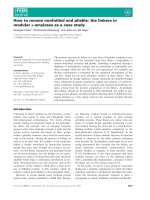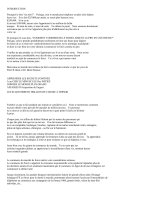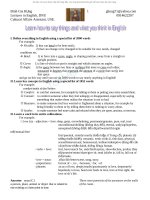How to identify high profit elliott wave trades in real time
Bạn đang xem bản rút gọn của tài liệu. Xem và tải ngay bản đầy đủ của tài liệu tại đây (11.2 MB, 204 trang )
How To Identify
High-Profit
Elliott Wave Trades
in Real Time
Pinpointing Optimal Entry/Exit Points with the C Wave Method
Myles Wilson Walker
About the Author
Myles Wilson Walker has been trading full time since 1986 for himself and
others. Initially skeptical about the value of Elliott Wave Principles, Mr. Walker
conducted an intense study of all available literature. His goal was to distill the
essential elements of Elliott's wave theory, then structure a successful trading
program around them that was tradable in real time. This Mr. Walker
accomplished, initially using the 24-hour currency markets as his main trading
medium, then expanding the analysis to incorporate virtually all major markets.
The results of this research are presented here in Mr. Walker's first book.
Mr. Walker was born in Auckland, New Zealand, where he currently resides.
Contents
Introduction ....................................................................................... vii
Chapter 1 Basics of Counting Waves ............................................... 1
Midpoint Method of Wave Counting 6
Chapter 2 Elliott Wave Principles ..................................................... 7
Impulse Waves
8 Corrective Waves
18
Chapter 3 Guidelines for Counting Waves ..................................... 35
Counting Waves 48
Detecting Elliott Wave Patterns and C Wave Patterns
Terms 51
Symbols of Wave Degree 53
51
Chapter 4 Logic of Counting Waves .............................................. 55
vi
Contents
Chapter 5 C Wave Patterns...............................................................f J
Method Objective for Impulsive and Corrective Markets
Trade Strategy 83
C Wave Patterns and Trading Rules 84
Strong B Waves and Trading Rules 88
Five Wave Corrections and Trading Rules 94
List of C Wave Patterns 98
82
Chapter 6 How To Find C Wave Patterns........................................ 103
Chapter 7 Profit Takes ......................................................................111
Chapter 8 Alternate Counts and Recounts .................................... 115
Trading Large C Waves
126
Chapter 9 C Wave Patterns on Daily and Intraday Charts .......... 129
N.Y. Silver
130 Deutschemark Spot
133
Chapter 10 C Wave Method in Action ........................................... 157
Entry 159
Managing the Trade
Conclusion 189
166
Summary ............................................................................. .'...............191
Appendix I Fibonacci in a Nutshell ............................................... 193
Appendix II Daily Worksheet .......................................................... 197
Index ................................................................................................. 207
Introduction
As a novice student, you would not expect to grasp the difficult concepts of
Elliott's Wave Principle instantly. Understanding and successfully using this
methodology for analyzing market price movements takes practice and
perseverance.
In essence, the Elliott Wave Principle maintains that markets advance or
decline in a series of wave patterns—five waves in the direction of the major
trend and three waves in the direction of the correction of the major trend. This
book is structured to help you broaden your knowledge base of Elliott's wave
analysis step-by-step. I suggest that your first reading be a quick scan of all the
material to give you an initial overview. Then, as you go back and study the
concepts, which are explained in numerous and subtly different ways, you will
find an approach that makes sense to you.
This book is essentially different from previous books on Elliott Wave in that I
have attempted to quantify aspects of the theory into practical and workable
guidelines with specific Buy and Sell patterns. There is no
vii
viii Introduction
longer any guesswork. You will be able to match the wave patterns as they are
happening in real time and execute the trade according to established rules.
One reason I wanted to publish this book was to pro vide other traders with
reliable Elliott Wave-based strat egies rather than a rehash of Elliott Wave theory.
Thus I have kept certain aspects of the theory to a minimus and presented the
material that I know from experi ence works. Until I can distill reliable rules, I feel
that it would be unfair to present other information as the truth when in fact it still
requires further research.
The first chapters of this book, which deal with Elliott Wave basics, will teach you
the concepts and help you understand the C wave patterns. These C wave patterns
are complete within themselves and stand alone without any other technical
indicators or other market inputs.
Chapter
1
Basics of Counting
Waves
Imagine a wave of water: It is made up of droplets. The I momentum of the water
flow has picked up the droplets and unified them in the same direction.
Between each wave is a trough of inactivity that sometimes runs counter as an
undercurrent. Waves of market activity behave much the same as waves of
water. At one moment all is quiet; then some new information hits the market
and everyone is active, the wave picks up and continues until it can no longer
be sustained. Then the market goes sideways through lack of activity or
countertrend (the wave trough) because of profit taking.
This ebb and flow of market activity represents the price waves that Ralph Nelson
Elliott categorized in his theory on market behavior during his pioneering work of
the late 1920s through the 1940s.
1
2
How To Identify High-Profit Elliott Wave Trades in Real Time
Simply, a wave is seen as one constant direction in price-until it either stops and
goes sideways or the direction totally changes.
This wave (wave 1) is an upward moving wave.
The next wave (wave 2) goes in the opposite direction. In this case, wave 2 is
going down.
If you could see more detail of wave 1, you would see that it is made up of
smaller waves—in this case five.
1/ Basics of Counting Waves 3
Wave 2 consists of three smaller waves. When any wave is made up of three
smaller waves, each wave is given a letter, in this case a = 1, b = 2, c = 3.
Or wave 1 could be made up of only three smaller waves. If the wave consists of
only three waves, it is marked as wave A or wave a.
If wave 1 were made up of only three waves, then wave 2 would always be
marked as wave B or wave b.
4 How To Identify High-Profit Elliott Wave Trades in Real Time
In this instance, the second wave is going sideways. A sideways price area is a
wave and must be counted.
If you could see more detail of the sideways price movement, you could see that it is
made up of smaller waves.
Wave 3 is made up of five smaller waves.
1 / Basics of Counting Waves 5
Wave B ends, and wave C follows! Wave C usually consists of five waves.
Wave 4 is made up of three waves (the same as wave 2).
When wave 5 ends, the waves are then counted as one wave. At this stage, a
movement (market correction) opposite the trend is expected.
6 How To identify High-Profit Elliott Wave Trades in Real Time
Midpoint Method of Wave Counting
Another way of counting waves, called the midpoint method, is to smooth the daily
data by using only the middle of the day's range. This method gives only one point of
data a day, which makes it easier to see possible waves.
The main drawback of the midpoint method is that it is not sensitive enough to detect
all the details of a C wave. However, when used in combination with detailed daily
charts, this method can be useful in offering fresh insight to a muddled trading
situation.
A single line connects the middle of each day's range.
Chapter
________________________________
2 ______
Elliott Wave Principles
A
ccording to Elliott Wave Theory, the market unfolds according to a basic
pattern of five waves up and three waves down to form a complete cycle of
eight waves. The five waves up, called impulsive waves, occur in the direction of
the trend. The three waves down, called corrective waves, are a price reaction
against the trend. A sideways market is also considered corrective.
Most market analysis is concerned with the 80 percent of the time that the
market is in a corrective state.
7
8 How To Identify High-Profit Elliott Wave Trades in Real Time
Impulse Waves
An impulse wave is a movement in the direction of the major trend. An impulse
wave must obey all the rules listed below (if it does not, the wave in question must
be classified as a correction even if it is also moving in the direction of the major
trend). Although this seems illogical at first, by applying the rules you will not mistake a running correction for an impulse.
Impulse Rules
The following rules apply to impulse waves:
• Wave 1, wave 3 and wave 5 are trending.
• Wave 2 and wave 4 are corrections.
• Of wave 1, wave 3 and wave 5, wave 3 must not
be the shortest.
• Wave 2 can retrace up to 99 percent of wave 1.
• Wave 4 may not retrace all of wave 3.
• Wave 4 should not go into the price area of wave 2.
(Sometimes it will pull back to the top of wave 1.)
• Wave 2 and wave 4 must display alternation in
as many ways as possible.
2 / Elliott Wave Principles 9
10 How To Identify High-Profit Elliott Wave Trades in Real Time
The structure of an impulse wave is illustrated here.
• Wave 1, wave 3 and wave 5 are trending.
• Wave 2 and wave 4 are corrections.
• Wave 4 does not go into the price area of wave 2.
• Of wave 1, wave 3 and wave 5, wave 3 is not the
shortest.
• Wave 2 and wave 4 display alternation.
2 / Elliott Wave Principles 11
Counting Waves
When deciding if a wave fits into either an impulse or corrective framework, look
for some basic visual things that will instantly show you the right category.
These are illustrated by the following two diagrams.
Correct
Count
Incorrect Count
(Wave 3 is too small)
Incorrect Count
(Wave 4 and wave 1 overlap)
Correct Count
12 How To Identify High-Profit Elliott Wave Trades in Real Time
Alternation
In an impulse move, alternation must occur between wave 2 and wave 4. That is,
wave 2 and wave 4 must be different in as many ways as possible, or at a minimum
in at least one way.
Alternation occurs between wave 2 and wave 4 as either price, time or pattern
type.
• Price: Wave 2 when compared to wave 4 may be
obviously smaller/larger in price.
• Time: Wave 2 when compared to wave 4 may take
much more/less time.
.
• Pattern: Wave 2 may be a simple ABC. Wave 4
could be a more complex A B C or even a fourth
wave triangle. Wave 2 could be a flat. Wave 4 could
be a zigzag or vice versa.
The following diagrams illustrate various forms of alternation.
In this diagram, there is alternation between
wave 2 and wave 4 in both price and pattern.
Wave 2 retraces more of wave 1 than wave 4
2 / Elliott Wave Principles 13
In this diagram, wave 2 and wave 4 display alternation in price, pattern and
time.
For a pattern to be impulsive, wave 2 and wave 4 must be noticeably different.
14 How To Identify High-Profit Elliott Wave Trades in Real Time
Wave 2 and wave 4 are too similar and show no alternation. The complete wave
sequence is corrective.
Degree
The waves on a monthly chart are much larger than those found on an intraday
chart comprised of two-hour time frames. If you study a price chart, the degree of
each wave is easily recognized. You can easily see that some waves consume more
time and price than others.
When dealing with small time frames, it is essential to group all the smaller waves
into bigger ones. The waves on a five-minute chart are grouped to make up an hourly
chart. The hourly chart is then grouped to make up a daily chart. The daily is
then grouped to make up a monthly chart and so on. The data on a five-minute chart
is of minor importance when viewed historically as compared to the data on a
monthly chart, thus the five-minute chart is said to be of much smaller degree than
the monthly.
To count waves properly, it is essential to group the waves of the same degree
together. This can be difficult since each wave can expand in time or extend in price
and still be of the same degree. Corrections are notorious for this, and it is easy to
get lost in the count until the correction is over, especially when you are dealing in
small time frames.
2 / Elliott Wave Principles 15
The rally from M to N was the same wave degree as the 1987 crash N to O.
The S&P chart on the following page shows that C wave patterns can be found on
waves of the smallest degree possible.
16 How To identify High-Profit Elliott Wave Trades in Real Time
Extensions
When you look at a price chart and compare the three impulse waves, you will
notice that one of them is longer than the rest. This longer wave is said to be
extended.
Waves extend because of market psychology. Traders recognize the trend and at
the point it becomes a common perception, the market starts to stretch. Very little
counter-trend action occurs since most players are waiting for reactions to join in or
add to positions.
During an extended wave, incredible amounts of price distance can be covered
with very little in the way of a pullback. The great danger here is that even if you
are
2 / Elliott Wave Principles 17
personally sure that the market is trending, you will not know which wave is
extending until well into the move. To prevent premature profit-taking on
position trades, you must be aware of the concept of the extended wave.
The diagram below demonstrates the concept that an impulse sequence
contains one wave that is noticeably longer than the others.
1
8 How To Identify High-Profit Elliott Wave Trades in Real Time
Corrective Waves
Corrective waves are comprised of three waves. Corrections move in the opposite
direction to the main trend. Therefore, the first wave (wave A) will be the reverse of
the trend. The second wave (wave B) will be in the direction of the trend. The last
wave (wave C) will be against the trend. Wave A and wave B may be comprised of five
waves of one smaller degree.
ABC Corrections
ABC corrections are the most common corrective structures with five wave triangles
following. As a trader, you are always looking for wave C to complete, so that you can reenter the market in the direction of the main trend.
These diagrams illustrate simple ABC corrections.









